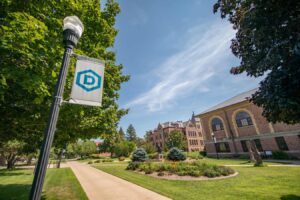We’re Live! At DSU Live

Can you hear that? That is the difference of how music sounds today versus decades ago; or so says Mason Wieman, President of DSU Live. As a Digital Sound Design major and a self-proclaimed music aficionado Mason is certainly the type of person who would know what to listen for. As I’ve seen him drag out equipment for various shows in the past, I have come to realize how passionate he is about working with the various technologies needed for live productions. Recently I spoke with Mason about the tech he uses, DSU Live, and his involvement with the organization.
DSU Live hosts entertainment events for students and for other organizations as well. Audio production students are the ones primarily involved which gives them opportunities for hands on experience before graduation. The live element is something that Mason finds very alluring about being involved with the organization. These events involve a lot of prep work beforehand to get things set up and often requires needing to think on your feet to fix problems that occur during events which is something Wieman find enjoyable about the job. Being involved with DSU Live has given him all the knowledge he needs to make things a success. “I knew nothing about audio, lighting, or anything before I came here.” In three short years he has traversed the group and now routinely can be seen setting up lights, speakers, and running wires as a one-man crew.
The star of every show for Mason is a Behringer X32 Producer sound board which allows for audio to be altered, boosted and mixed with music for live production. This sound board can be controlled wirelessly with an iPad which gives more flexibility with tuning the acoustics of a room before a show. The ability to be programmed for multiple presets allowed for quicker transitions between acts during the Roctober event Live hosted in October last year. The group is also getting into recording which was utilized for the show in October. The sound board was used to record audio which was later edited with video of the event to demonstrating the work of DSU Live. The other equipment consists of industry standard lighting and XLR cables which are “classic microphone cables.” DMIS lighting software is used to control the multitude of various lights that are essential for shows. The speakers they use have built in amps streamlining the number of components needed and making setup that much quicker.
As the process of altering music has changed through the years it has become increasingly easier for people to get involved. Technology has allowed the ability to produce many more effects and combine them to develop new techniques with minimal equipment needed to get started. The old way of editing involved actually cutting and splicing audio tapes known as “destructive editing.” Now with the digitization of sound production it is easy to undo mistakes and quickly try new things. Mason told me “you can hear how far it has come” referring to how the different types of editing produce a difference in sound. With each new process for recording, editing, and listening to music there have been new elements added for people like Mason to appreciate while listening to either a live event or a recording of a favorite song.
The internet also makes it easy to find samples and effects that audio producers can use in both live productions as well as mixing original tracks. Mason let me know that with the proliferation of YouTube it is possible to find any song someone could imagine. DSU Live recently put on a karaoke event in which they took advantage of this. They are planning to host monthly karaoke events this semester which means whatever you enjoy singing will most likely be available. The organization puts out posters in advance of events so be sure to keep an eye out for the next opportunity to show off your vocal and musical skills.








